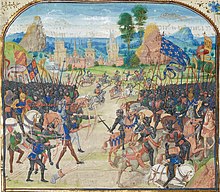Sir Nigel
It is the background story to Doyle's earlier novel The White Company (1891), and describes the early life of that book's hero, Nigel Loring, a knight in the service of King Edward III in the first phase of the Hundred Years' War.
The tale traces the fortunes of the family of Loring of the Manor of Tilford in Surrey, many of whose members had been prominent in the service of the Norman and Angevin kings of England, against the backdrop of the Black Death.
The tale starts with the problems the family and its last scion, Nigel Loring, face at the hands of the monks of Waverley Abbey, up to the coming of Sir John Chandos.
In order to make himself worthy of the hand of the Lady Mary, daughter of Sir John Buttesthorn, he vows to perform three deeds of honour.
The tale is a rendition of the Battle of Les Espagnols sur Mer (August 1351), as chronicled by Froissart, with a fictional storyline weaved in skilfully with the history.
With the assistance of Black Simon of Norwich, a very prominent character in the series, and man-at-arms in the army, and some of the peasants of the surrounding country who hate La Brohinière for his cruelty and deeds, Nigel penetrates the connecting passage between the main castle and one of its outworks.
But news of a truce between England and France precedes their arrival and serves to dampen their spirit until a visit by the French seneschal Robert of Beaumanoir, Master of Josselin.
The French lord proposes a passage of arms, and since a reason would be necessary to justify such a violation of the truce, to the two kings of England and France, he proceeds to pick a mock-quarrel with Nigel Loring.
This incident is a thinly veiled account of the famed Combat of the Thirty of March 1351, which is of importance in Breton history and in the annals of chivalry, as being an exemplary passage of arms.
